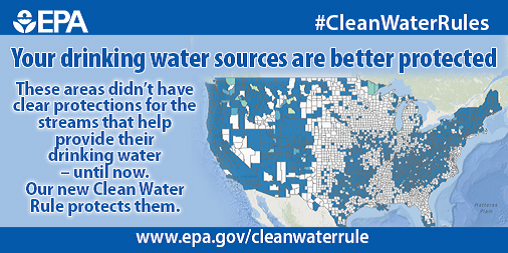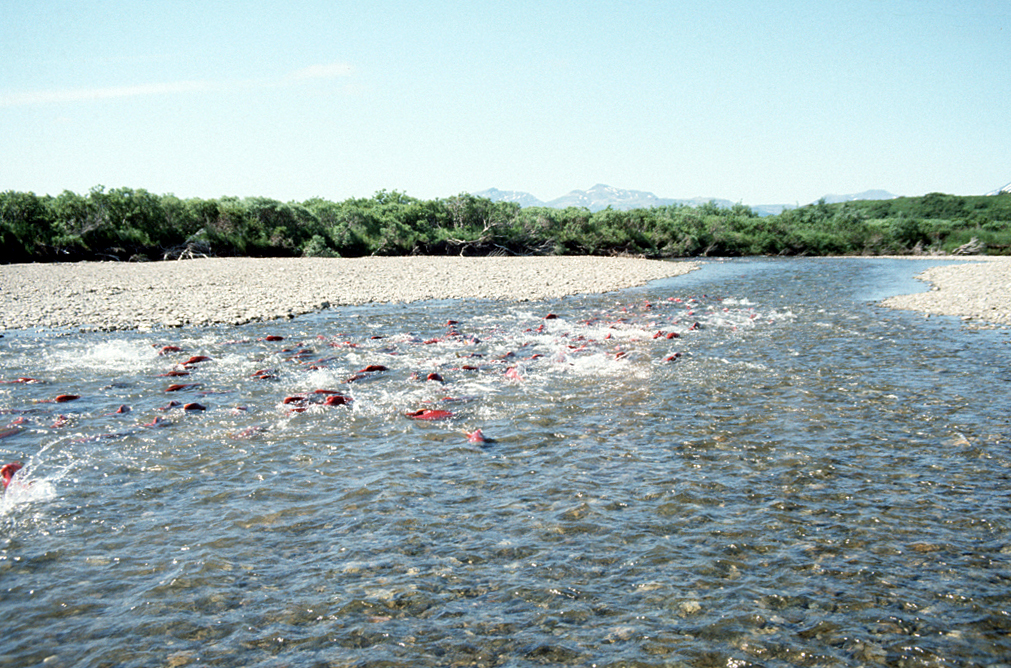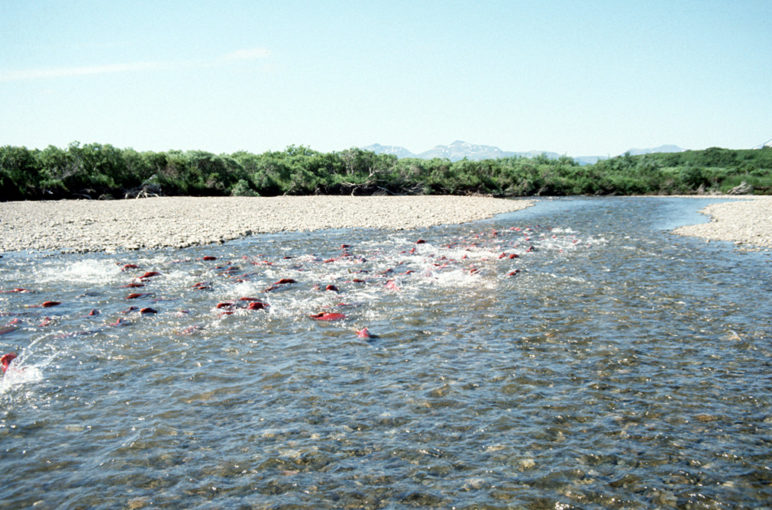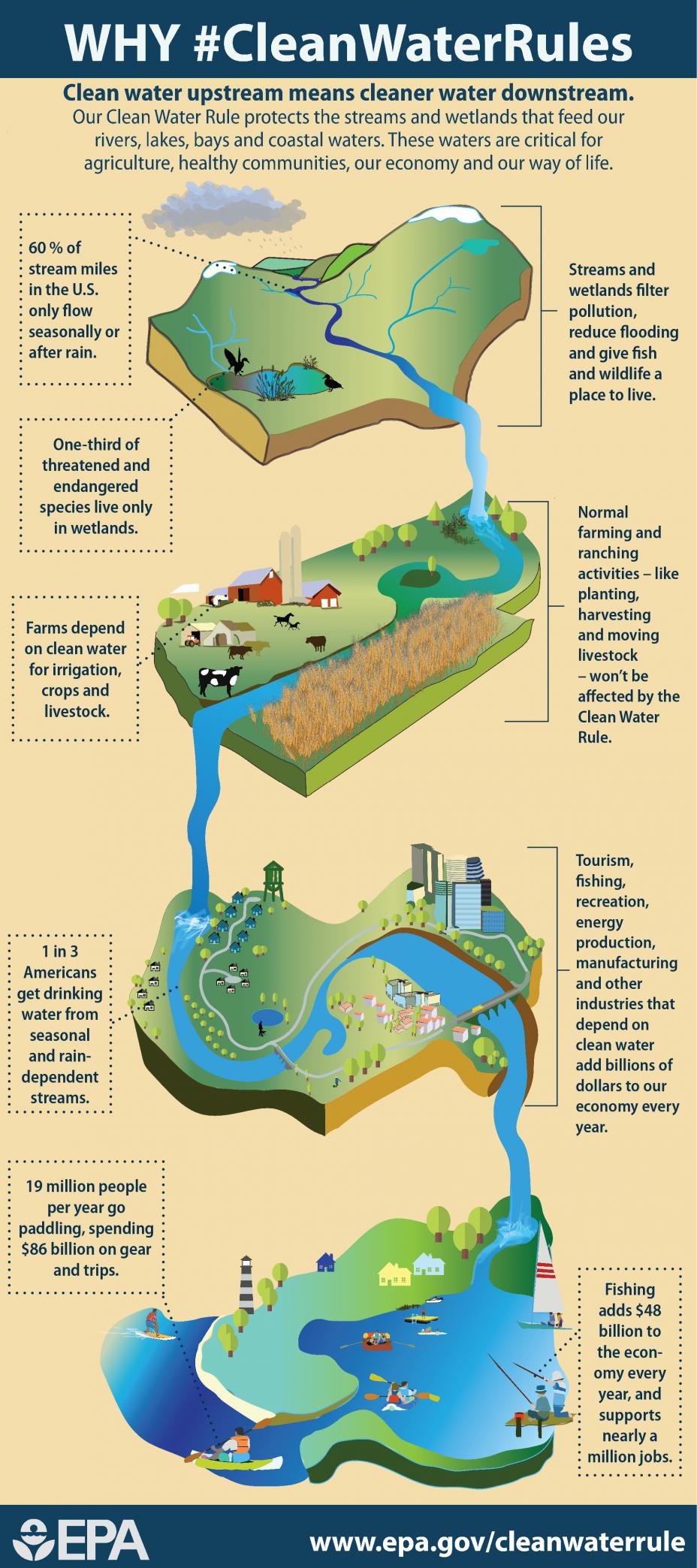“Repeal and replace” may be coming to a stream or wetland near you. A Trump Administration initiative to overturn Obama-era protections for some small waterways could threaten environmental health, and maybe drinking water sources, for over 100 million US residents, including at least 4 million in the Northwest. Following a presidential Executive Order, EPA Administrator Scott Pruitt has proposed to reverse the 2015 Clean Water Rule, which provides valuable protections for “national treasures” such as Puget Sound.
How did this situation come about? The story starts with the Clean Water Act, one of the nation’s primary environmental protection laws, which establishes federal jurisdiction over “navigable waters,” and “waters of the United States, including territorial seas.” Yet science indicates that protections limited to “navigable” waters could be severely undercut by pollution in smaller tributaries and wetlands that feed into the main waterway. Indeed, as early as 1985, in United States v. Riverside Bayview Homes, the Supreme Court of the United States (SCOTUS) held that wetlands that intermingle with navigable waters are themselves “waters of the United States,” and therefore fall under Clean Water Act jurisdiction.

Figure showing areas where the Clean Water Rule would protect streams providing drinking water; darker colors show higher proportions of drinking water provided by streams. by EPA Archives (license)
In 2006, however, the Roberts Supreme Court complicated the issue of federal jurisdiction in Rapanos v. United States by issuing a 4-1-4 decision, which because it was a tie set no binding case law. The issue in question was the extent of the US Army Corps of Engineers jurisdiction over wetlands when the agency issues permits for the discharge of dredge or fill material into “waters of the United States” under the Clean Water Act. The lone opinion by Justice Kennedy concurred with one of the plurality decisions that the Corps had exceeded its authority by regulating a relatively remote wetland. But Kennedy also concluded that a wetland or non-navigable waterway would fall within Clean Water Act jurisdiction if there were a “significant nexus,” to a traditional navigable waterbody, affecting the integrity of the downstream water. Justice Stevens, author of the other plurality opinion, supported the Corps’ interpretation in the case, and further assumed that Justice Kennedy’s “approach will be controlling in most cases.”
After Rapanos, EPA and the Army Corps attempted for several years to interpret what constitutes a “significant nexus.” After some unsuccessful efforts by previous presidential administrations and Congress, the Obama administration in 2011proposed its “Clean Water Rule,” designed to clarify exactly which Waters of the United States (WOTUS) are subject to the Clean Water Act.
Much analysis supported the new rule. In fact, EPA issued a synthesis of more than 1,200 peer-reviewed scientific publications showing that the small streams and wetlands the rule would protect are vital to larger, downstream navigable waters. The Agency also held more than 400 meetings with stakeholders across the country, and received over one million comments—more than 80 percent of which were in support of the rule. In June 2015, the administration promulgated its final Clean Water Rule, to take effect two months later.
In endorsing the measure, then-President Obama noted, “This rule will provide the clarity and certainty businesses and industry need about which waters are protected by the Clean Water Act, and it will ensure polluters who knowingly threaten our waters can be held accountable… With today’s rule, we take another step towards protecting the waters that belong to all of us.” Then-EPA Administrator, Gina McCarthy, reported that the additional protections would expand the number of water bodies covered by the Clean Water Act by only about 3 percent. Nonetheless, some industries, including agriculture and energy, opposed the rule, thirteen states sued the federal government over it, and federal courts issued decisions blocking its implementation nationwide.
Then, in February 2018, President Trump (POTUS), issued an executive order directing EPA and the Army Corps to review the Clean Water Rule. But Trump’s initiative was plagued with problems from the outset. The Washington Post fact-checked his claim that the Rule has cost “hundreds of thousands” of jobs, and awarded him Four Pinocchio’s (a falsehood Whopper). He also failed to acknowledge his inherent business of interest conflict, since revoking the rule could avoid costs at his golf courses. Moreover, in proposing to revoke the rule, EPA Administrator Pruitt omitted his own legal history: as Oklahoma State Attorney General he had sued EPA over this very same Rule.
What’s next? EPA has invited public comment on its proposal to rescind the Clean Water Rule, with a deadline of September 27, 2017. Citizens can submit comments via an EPA web page, following the directions at the bottom of the “Step One” material.
Earthjustice is already on the case. As the environmental law firm explains, revoking the Rule would remove protections for waters critical to drinking water, recreation, and wildlife. Readers can view the Earthjustice arguments, sign on, and/or add their own personal comments, at this embedded link. The organization is more than halfway toward its goal of 75,000 signatures.
John Abbotts is a former Sightline research consultant who occasionally submits material that Sightline staff members turn into articles.












linda godfrey
We absolutely need the Clean Water Act. This is vital to our survival. All polluters violating this clean water ptotection need to be held accountable.
John Abbotts
Hello Readers,
The deadline for comments to EPA is September 27, 2017.
My apologies to Sightline and its followers.
Steve Erickson
The ultimate legal problem here is that we have politicians and judges who are environmental illiterates. Hence, jurisdiction accrues to the federal (US) government based on whether the water goes to navigable waters, triggering the commerce clause and federal jurisdiction.
Our elected and appointed leaders have not caught up to the science, which is pretty clear that water does not respect political (state) boundaries, whether above or below the surface. Its an entirely artificial construct to act as if gravity, transpiration, evaporation, and precipitation do not exist. The Clean Water Rule is a tiny baby step in the right direction.
John Abbotts
My thanks to Sightline editors for inserting the correct deadline for comments to EPA.
My thanks to the other comments for their observations and interest in Sightline’s work.
Ginny Hazen Damman
We need a clean water act!!
John Abbotts
An update here to incorporate another Sightline Daily headline, this one on drinking water, at https://www.hcn.org/articles/south-water-im-scared-of-getting-sick-from-the-water
And, I take full responsibility for comments here. With regard to the Clean Water Plan, reinstating it, either the Ob/Biden administration plan, or by the Biden/Harris EPA, is likely to run into the US Supreme Court, which with the new Trump majority [6-3, with the corporate-appeasing 6 composed of Clarence Thomas, appointed by H.W. Bush; Roberts and Alito, appointed by Cheney/Bush (we know who was in charge); and the most recent appointees, Gorsuch, Kavanaugh, Barrett (comment withheld on each of them to avoid libel charges)], historical link at https://www.senate.gov/legislative/nominations/SupremeCourtNominations1789present.htm.
However, as the High Country News (HCN) link above describes, Help could the on the way in the form on new Green, Infrastructure, which Biden/Harris/Chuck Schumer hope to get through the Senate on a 50-50 vote, plus Kamala. EPA does have a revolving Clean Water State Revolving Fund (CWSRF), to support improvements to both State Drinking Water and water quality treatment plants [sewage treatment, to be more blunt] to comply with the Clean Water Act. Perhaps the most publicly recognized need to improve drinking water is to replace old lead pipes, left over for perhaps centuries, in municipal drinking water systems. But the revolving fund could also be applied to smaller community systems that support low-income or minority populations that face contaminants such as arsenic and other toxics.
However, on Water system improvements, the Senate very recently passed a bipartisan [can you believe?] $35 billion water infrastructure bill, link at https://www.cbsnews.com/news/water-infrastructure-bill-senate/
Bill sponsors were Senator Carper (Delaware, sometimes called a “Biden whisperer”), and Shelley Moore Capito (WV), the chair and ranking member of the Senate Environment and Public Works Committee.
The total $35 billion is literally a “drop in the bucket,” compared to Biden/Harris $2 trillion, but it does show that clean water is popular.
If readers want to follow up, Earthjustice has this action alert on restoring the Clean Water Act, to be delivered to the US Senate https://earthjustice.org/action/restore-the-clean-water-act
The Supreme Court is still a potential obstacle, but the Court is more likely to defer to Congress than to a federal agency trying to interpret and implement legislation. The Supreme Court tends to follows “the election returns,” as they [mostly] did for the 2020 election. The phrase has been attributed to a fictional Irish immigrant bartender, “Mr. Dooley,” created by a US journalist at the end of the 19th century, link at https://en.wikipedia.org/wiki/Mr._Dooley
Before my Irish brethren beat me about the head and shoulders and ban me from the next St. Patrick Days parade, I point out that my family is part Irish, and I find the character, who often spoke in dialect (“th’ iliction”) amusing. I said once that I am sensitive enough to know that I am insensitive, and a female friend laughed and told me, “that is very Zen.”
Hope that is enough to be forgiven.
I will ask Sightline editors to please pardon my rambling, but the material above may be enough for an updated article. Or NOT, as SL sees fit.
All stay safe from science denial hazards [especially if you are still reading],
John Abbotts
Another day, another update. Earthjustice announced that an a federal judge for the US District Court for Arizona revoked Trump’s Navigable Waters Protection Rule “because the rule contains serious errors and has the potential to cause significant harm to the Nation’s Waters if left in place while the Biden administration works on revisions to the rule.” Earthjustice represented six Native American Tribes in their suit to overturn the rule, which they designated as Trump’s Dirty Water Rule, link at https://earthjustice.org/news/press/2021/judges-ditches-trumps-dirty-water-rule
The Tribes collectively cover multiple states, including the Quinault Indian Nation, whose reservation lies on the Olympic Peninsula.
Now, the Biden administration is working on a revised EPA rule, and there should be opportunities for public comment as they do so.
There is also the chance for “legal ping-pong” if the Supreme Court, mentioned in an earlier comment, shows that it really has been captured by Trump Treason [dare I say?] Republicans, if it strikes down EPA’s new rule on behalf of corporate interests. Nonetheless, the Clean Water Act allows individual states to establish stronger protections on clean water than federal standards.
All stay safe from all science denial hazards,
John Abbotts
In the “here we go again,” category, the US Supreme Court, now 6-3 right wing thanks to Trump and Mitch McConnell, announced it will take up a case on the Clean Water Act that was earlier decided, link at https://thehill.com/policy/energy-environment/591023-supreme-court-to-review-which-wetlands-get-federal-water.
Will this court, which has already done damage to vaccination, un-gerrymandered voting districts, and a women’s right to control her body, now turn its pro-corporate sights on environmental legislation? If so, there should be opportunities for public comment as EPA works through new regulations. Stay tuned.
John Abbotts
Hello again,
I should make clear that the opinions expressed here are my own. But a more detailed analysis of the 6-3 Court’s positions, including accepting the legal challenge on wetlands and on climate protections, can be found at https://www.thenation.com/article/environment/supreme-court-climate-change/
Elie Mystal, Justice Correspondent for The Nation magazine, argues that the Court’s decision against the Biden/Harris administration’s “vaccine or test” requirement on COVID, was an attack on the “administrative state,” [read protections for public health, the environment; and restrictions on corporate greed].
In fact, The Nation article cites US Senators who filed an amicus brief, asking the Court not to accept the challenge to EPA’s authority to regulate carbon emissions, because it would reflect the Trump administration’s efforts to “deconstruct the administrative state.”
The article concludes: “Climate change does not care about the administrative state. Rising seas are not waiting for the Koch network to invest in dams. The extinction of the planet’s biodiversity is not deferring to the conservative ideological crusade. Doing nothing for 30 years as we wait out conservative control of the Supreme Court is simply not an option.”
FWIW, I concur.
All stay safe from all science denial hazards,
John Abbotts
Another Sightline Headline, another update; again, I take full responsibility for the comments herein. The headline links to, https://www.opb.org/article/2022/12/30/epa-finalizes-water-rule-that-repeals-trump-era-changes/?utm_source=Sightline%20Institute&utm_medium=web-email&utm_campaign=Sightline%20News%20Selections
Briefly, the Biden/Harris EPA has issued the latest version of the “Waters of the US” (WOTUS) rule, retaining the framework of the Obama/Biden Clean Water Rule, and responding to public comments on the rulemaking that began in February 2022. The Agency’s Final Rule publication is 514 pages, at https://www.epa.gov/system/files/documents/2022-12/Pre-Publication%20Final%20Rule%20Notice.pdf
and provides a citation to the rulemaking Public Docket on how the Agency responded to court decisions on the topic and numerous public comments on the proposed rule, including comments from Tribes describing how Clean Water is important to their livelihoods and cultures.
However, one can expect a challenge from industry, which may have the effect of delaying the rule further due to SCOTUS “ping-pong.” So there may be additional opportunities for public comment on the rule, depending on what SCOTUS decides. Watch this space, or maybe just the news. Of course, there is always the opportunity to “vote on the court,” in the next election, as so many citizens voted in favor of reproductive choice during 2022.
All stay safe, from the “tridemic” and science denial hazards.
John
Well, the story gets longer. 24 states with Republican-led governments sued EPA over the Biden/Harris administration’s clean water rules, link at https://thehill.com/policy/energy-environment/3862199-two-dozen-republican-led-states-sue-epa-over-water-protection-rule/ . I would say, “just as I predicted,” but it is not unexpected [see above]. The same article also noted that SCOTUS was expected to issue an opinion on a wetlands case that it heard in October.
As noted in an earlier comment, EPA’s latest Clean Water rule was explained in the a 514 page Federal Register notice. This gives the agency a lot of material to use against the latest suit. What will the 6-3 Roberts/Trump/McConnell court find? Stay tuned, but there may be more opportunities for the public to comment on proposed EPA regulations; and/or for voters to make SCOTUS an issue in elections. Not saying how folks should vote; that might be considered partisan.
All stay safe,
John Abbotts
Well, another Headline item, another travesty from the Roberts/Trump/McConnell Supreme Court. Responsibility for these comments lies with myself alone; and I will start with, “Oink.”
Earthjustice posted its analysis at https://earthjustice.org/article/what-does-sackett-v-epa-mean-for-clean-water
To summarize, “The Supreme Court just ruled that as many as half of the 118 million acres of wetlands in the U.S. are no longer protected by the Clean Water Act, embracing the decades-long demands of mining companies, the fossil fuel industry, reckless developers, and other big polluters. The court’s decision in Sackett v. EPA puts our communities, public health, and local ecosystems in danger.”
“The Supreme Court decided Sackett v. EPA today [May 26, 2023]. It’s bad, for all the reasons you might think an opinion about the Clean Water Act from this Court would be. But it’s particularly bad because of the seeds it plants for future attacks on statutes like the CWA.”
The legal question here is that the Clean Water Act (CWA) prohibits dumping pollution into “navigable waters,” a term that is defined to mean “waters of the United States” (WOTUS for shorthand). The case turns on what WOTUS means.
“Everyone agrees that the term covers *some* wetlands. That’s because the CWA elsewhere refers to “navigable waters . . . including wetlands adjacent thereto.” This makes it clear that WOTUS “includ[es]” adjacent wetlands. That’s where the agreement ends.”
The decision was 5-4, with Kavanaugh departing from his other usual Republican operatives/corporate attorneys/”Mastodons of a New Confederacy” (MOAN-C).
[Pardon the partisan insults, but again, they are my responsibility alone]
“Five Justices say it means a wetland must have “a continuous surface connection to” a water body like a stream, lake, or ocean such that there is “no clear demarcation” between the two.”
“The other four Justices (Kavanaugh, Sotomayor, Kagan, and Jackson) rely on the ordinary meaning of a pretty ordinary word to say that “adjacent” means, basically, very close to. Why does this matter? A few pictures of the area at issue in this case show why.” [see the link to Earthjustice above for photos]
“You don’t need a science degree to know (and the record shows) that the wetlands on the Sacketts’ property are connected to the fen (wetland) across the road and the lake a football field away.”
Moreover, “The majority’s reasoning doesn’t just affect this case, or even just environmental statutes. Like the major questions doctrine in West Virginia v. EPA, the opinion in Sackett gives those who want to attack the statutes that protect our health and safety new ammunition to do so.”
Or, as Elie Mystal, Justice Correspondent for The Nation magazine, has argued before [above], at https://www.thenation.com/article/environment/supreme-court-climate-change/
The Court’s decision against the Biden/Harris administration’s latest proposed rule on WOTUS, the 514 page notice reported above, represents another attack on the “administrative state,” [read protections for public health, the environment; and restrictions on corporate greed].
In fact, The Nation article cites US Senators who filed an amicus brief, asking the Court not to accept the challenge to EPA’s authority to regulate carbon emissions, because it would reflect the Trump administration’s efforts to “deconstruct the administrative state.”
The article concludes: “Climate change does not care about the administrative state. Rising seas are not waiting for the Koch network to invest in dams. The extinction of the planet’s biodiversity is not deferring to the conservative ideological crusade. Doing nothing for 30 years as we wait out conservative control of the Supreme Court is simply not an option.”
All the more reason for asking that the Court set ethics rules for itself, and/or the Congress impeach Clarence Thomas for his ethical blind spots, and remove him from office.
And btw, Alito wrote the majority opinion for Sackett, and he needs to be removed because of his own ethical questions, see https://www.theguardian.com/law/2023/mar/24/us-supreme-court-ethics-code-clarence-thomas; not to mention his decision terminating abortion as a right, based on his own religious beliefs and an opinion that SNL lampooned as positively medieval, see https://www.youtube.com/watch?v=mLMp-1NdzR8
That said,
All stay safe,